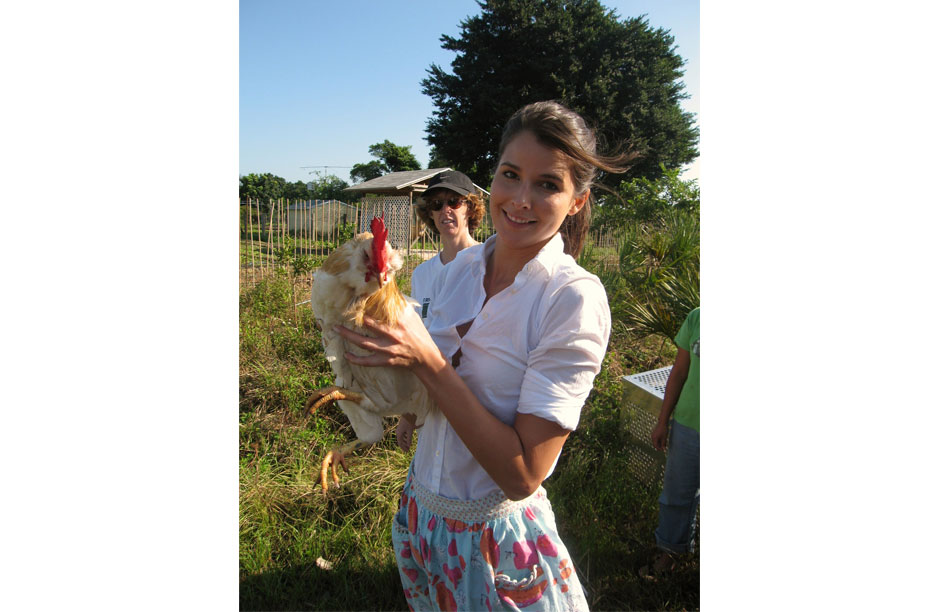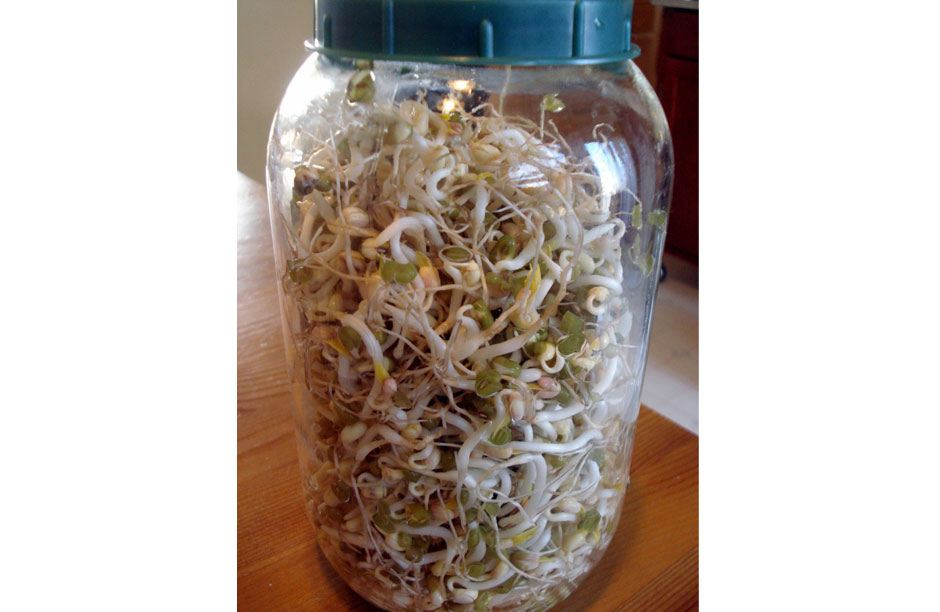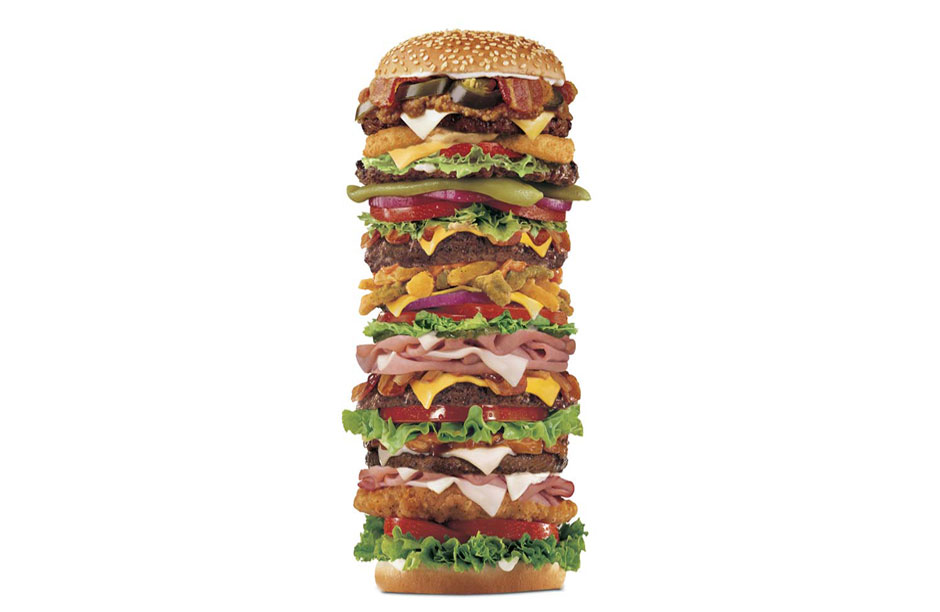PAST ISSUES
 Students of health and nutrition at the Hippocrates Institute in West Palm Beach, FL flaunt their trays of homegrown wheatgrass.
Students of health and nutrition at the Hippocrates Institute in West Palm Beach, FL flaunt their trays of homegrown wheatgrass. The author, Julie Hooper, with the chicken she is about to slaughter.
The author, Julie Hooper, with the chicken she is about to slaughter. There's a growing movement in nutrition for sprouting your own seeds - a great source of protein and live enzymes to aid in digestion.
There's a growing movement in nutrition for sprouting your own seeds - a great source of protein and live enzymes to aid in digestion. S.A.D stands for The Standard American Diet.
S.A.D stands for The Standard American Diet.
American Health is S.A.D.
By Julie HooperI’ve been on my own health journey for a while now, and along the way I have encountered some fairly strange yet significant scenarios – voluntarily slaughtering a chicken not necessarily being the most bizarre among them. Today I am a health counselor, and it all started with the question “What to eat?” It is the question that I help my clients with on a daily basis, but since when did it become so hard to figure out?
I asked myself this at the young age of 18 after I moved from the land of meat and potatoes to a model’s apartment in NYC. I tried on vegetarianism for the first time, mainly for reasons of vanity – I needed to slim down for work – but there was also an added “feel-good” bonus of not killing animals for food. After years of modeling around the world and watching young girls struggle with eating disorders, my quest to find the basic answer of “what to eat?” became deeply ingrained in me. These experiences lead me to where I am now – supporting those in the spotlight who not only need to look and feel their best every day, but need to be their best too.
As I strutted down this runway of life, the “what to eat” question became more absurd. It seems that society has lost the innate ability to know what to eat. As we focus on all of the separate pieces surrounding our health–“This is good for that” and “that prevents this.”—We’ve forgotten that our body is a machine whose parts rely on each other. We don’t have kidneys that operate on their own, or a liver that’s just hanging out doing it’s own thing – everything is dependent on something else and we need to treat our bodies as a whole rather than the sum of its parts.
The journey I was on eventually forced me to look at the overall health of Americans today. It’s no wonder young girls didn’t know what to eat. Most people struggle with this on some level, at some point, consciously or not. Our health as Americans is in bad shape and our diet is what needs to change. Coincidentally, yet aptly named, the average American’s diet is referred to by its acronym SAD (Standard American Diet).
We are in such a health crisis that our First Lady, Michelle Obama has taken on child obesity as her number one initiative. She calls it an “epidemic”. Once referred to as Adult Onset, Type II Diabetes is now affecting children at alarming rates. Adult Onset, Type II Diabetes is now affecting children at alarming rates. Dr. David Katz, from Yale School of Public Health, estimates that 80% of American adults range from overweight to obese and 80 million of us are insulin resistant and journeying towards Type II Diabetes. According to The National Diabetes Statistics from 2007, of the 23.6 million Americans that have Diabetes, 90-95% are Type II. Not only that, but according to the CDC, 631,636 people died from heart disease in 2006 – that’s 26% of all deaths for the year. Rates for most cancers have had a significant rise in the last 30 years but the exact figures are difficult to know (it can take anywhere from 4-17 years for accurate recording). Some of these statistics are attributed to our longer life span, but an estimated mind-blowing 65-90% of the climb is due to environmental factors and lifestyle choices such as diet. So it doesn’t take a degree in health and nutrition to realize that as a nation our health journey is in a SAD state of affairs.
Today most doctors are unaware of what to recommend to their patients. It’s not their fault. Very few nutrition classes are necessary requirements in their formal education. Many of these diseases can be treated, or at least prevented with diet and lifestyle changes. Walter Willet, Chair of the Department of Nutrition for Harvard School of Public Health, was responsible for banning trans fats in New York City. He proved through his research that 500 deaths per year would be prevented, which is more than the number of automobile related deaths in NYC each year. That’s only one small dietary change, but it delivers such a significant impact on health.
In the media diseases like heart disease, diabetes, obesity, and cancer get paraded around like reality TV stars, mainly because they are so prevalent. Again, like our bodies, we often see diseases as separate from one another. Yet, for every disease the root source is found in the same place, our bodies, and the cause can often be traced to a small number of aggravated sources.
They say when you truly know something you “feel it in your gut”. Your gut is given credit for your center of intuition, an intelligence that can often surpass that of the brain’s. Yet, people often overlook their “gut” as the source of good or bad health. Having a healthy digestive tract is much more important than most people think. Recently it has been given credit with over half of our immune function! Much of the food we eat tends to be “pro-inflammatory”, which means acidic conditions are where disease thrives, especially in the gut. We have a delicate balance of good bacteria that can easily become out of balance with poor dietary practices. In addition the high number of medications that Americans take can create a ground zero for good bacteria with just one dose of antibiotics. In order to restore and support these colonies of beneficial bacterial (which outnumber the amount of cells in our body by 10 times), we must include fermented foods that contain “probiotics” such as raw sauerkraut, kimchi, kombutcha (or fermented tea), miso, tempeh, yogurt, kefir or apple cider vinegar in our diets. If these cannot be worked into your diet, it is suggested to take a probiotic supplement, especially after taking antibiotics.
The root cause of most disease is chronic inflammation and there seems to be a link between this and being too acidic. Inflammation is the body’s response to injury or infection – it’s the body’s way of bringing more nutrients and immune activity to an area. Unfortunately, excess inflammation in the body has been associated with obesity, type II diabetes, heart disease, cancer, Alzheimer’s, asthma, and autoimmune disease. Eating a diet that combats inflammation in the body, taking care of your digestive health and making small lifestyle changes can significantly lower your chance of dis-ease in the body.
An anti-inflammatory diet consists of a balance of omega 3 and 6. Most people have an excess of omega 6 fatty acids in their diets, which are found primarily in snack foods, fast foods and vegetable oils. Omega 3’s are found in flax, hemp, walnuts, and oily fish. It is strongly suggested to cut out all trans-fats in the diet, which are found in margarine, hydrogenated vegetable oils and vegetable shortening. Sugars in the form of refined and processed foods, white bread, potatoes, and sugary food products, especially those containing high fructose corn syrup promote inflammation in the body. As this is the basis of most foods in America it is no wonder chronic health conditions are on the rise.
An easy way to implement an anti-inflammatory diet is to divide your plate into thirds. One third should be a salad with olive oil, flax seed oil, or avocado based dressing with highly alkalizing, enzyme and protein rich sprouts on top. The next third should be a non-starchy vegetable or mix of vegetables. It’s important to include a few from the Cruciferous family (like cauliflower, kale, or broccoli). The last third should be either a vegetable based protein from sprouts, a combination of legumes, whole grains, seeds and nuts, or a lean piece of meat the size of your palm (think oily fish).
The China Study, arguably called the most comprehensive study of nutrition ever
conducted, concluded that when less than 10% of the daily caloric intake is animal based there is a very low occurrence of cancer. Other lifestyle changes that reduce inflammation and promote health and healing in the body are getting enough rest, and reducing stress. It’s also important to stay hydrated and throughout your journey learn how to listen to your body. I have learned not to eat something just because it is supposed to be healthy, but instead to notice if my body is telling me otherwise.
“Let thy food be thy medicine.” Ann Wigmore, who founded the Hippocrates Institute (in Boston) and the Ann Wigmore Institute in Puerto Rico, lived by this – literally. Growing up in Lithuania in the early 1900’s, Ann learned from her grandmother that a variety of illnesses respond to the healing properties of medicinal plants, grasses and herbs. She used these principles to heal herself from serious conditions such as gangrene and colon cancer. In order to have access to these chlorophyll-rich foods during the winter months she was the first person to grow wheatgrass for juice. It became the staple of her recipe for healing the body.
The Hippocrates Institute, now located in West Palm Beach, Florida has dedicated themselves to healing and teaching a new food lifestyle to anyone who would like to learn. It’s main goal is “to assist people in taking responsibility for their lives and to help them realize and actualize an existence free from premature aging, disease and needless pain.” Using less invasive therapies that stimulate the immune system and support the healing process, they focus on intestinal, lymphatic and emotional cleansing, blood analysis, and alkalizing the body by eating a raw, living diet rich in super foods. Some of the therapies on site are mineral baths, far-infrared sauna, colon hydrotherapy, body work, psychotherapy, mind body therapies and massage as well as facials (or healthsthetics as they call it). Since this lifestyle is so detoxifying there is a strong emphasis on elimination making sure that the bowels and lymphatic systems are moving and that toxins are also released through the skin by sweating. Living foods are foods that are rich in enzymes, the catalysts for all bodily functions. The reason why enzymes are so important is because we need them to digest our food and we only have a certain amount of them. As we age we deplete our enzymes by eating highly processed foods and our digestion then becomes less efficient. The Hippocrates lifestyle puts emphasis on wheatgrass, coconut water, sprouts, organic vegetables, fruits that are not too sweet, fermented sauerkraut and sea vegetables.
I had the opportunity to attend The Ann Wigmore Institute in Puerto Rico for two weeks a few summers ago. I learned how to open a coconut with a machete, give myself an enema, and how to put wheatgrass into just about every place in and on my body. Afterwards my skin was glowing and impeccable, my nails grew longer than ever for the next year and I was full of energy. It was truly a remarkable experience.
So where are you on your health journey? No matter where you are, the most important thing is that you are on the path and staying positive. In the words of Joshua Rosenthal founder of Integrative Nutrition in NYC “treat your health as if your life depends on it, because it really does.”